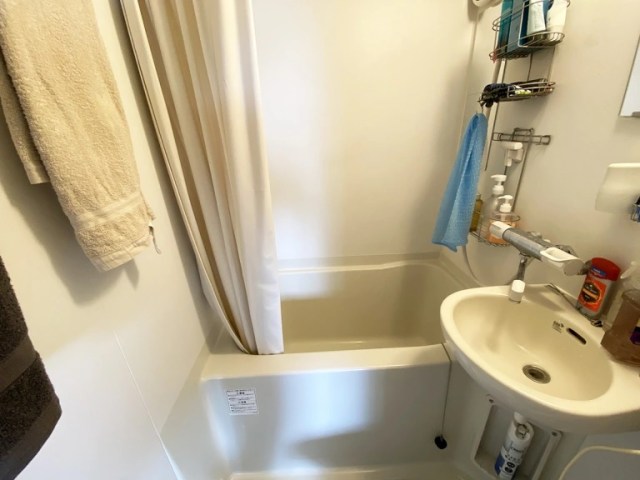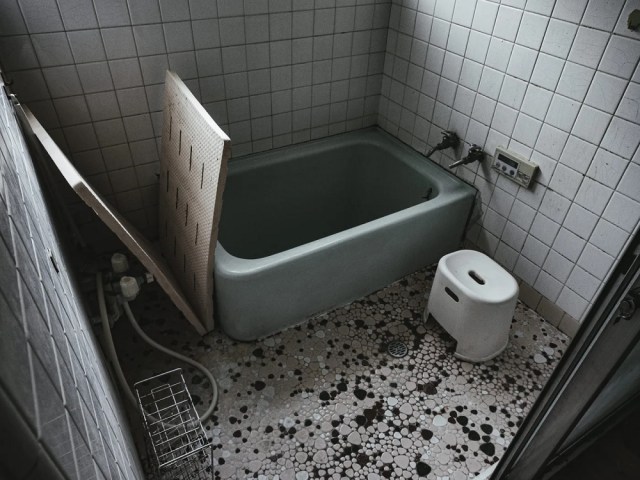
No bath, no problem?
When looking for an apartment in Japan, you can save a lot of money on rent if there’s some amenity or nicety you’re willing to do without. Choosing an above-ground-level unit in a building with no elevator, for example, or an apartment with just a basic toilet, not one of Japan’s fancy washlet models, can easily knock 10,000 yen or more off your monthly housing expenses.
But according to Japan’s TV Asahi news, some young Japanese people are going even farther than that, and looking for apartments without a bathtub or shower.
The financial appeal is significant. TV Asahi spoke with a 20-something Tokyoite living in a bath/shower-less studio apartment near Nerima Station, just a 10-minute train ride from downtown Tokyo, paying just 32,000 yen (US$245) a month. Another no-shower apartment dweller is within walking distance of Tabata Station on the Yamanote Line, the loop line that runs around the center of Tokyo, whose rent is almost as cheap, at 33,000 yen a month.
An apartment with no bathing facilities might sound like it’d exclude you from all but the most odor-accepting workplaces and social circles, but it’s actually not as much of an obstacle in Japan as it would be in many other countries. That’s because you can still find sento, or public bathhouses, in Japanese towns. They’re not nearly as common as they used to be, but in a city with as many people as Tokyo, sento haven’t completely disappeared. There’s even a website, Tokyo Sento Fudosan (“Tokyo Public Bath Real Estate”), that specializes in helping renters find no-bath apartments that are within a short distance of a public bath.
▼ A look at some public baths and no-bath apartments
According to Tokyo Sento Fudosan, it’s not necessarily economic hardship that’s causing people to seek out these low-cost, few-frill apartments. Instead, the realtor says, there’s an appeal to the retro atmosphere. No-bath apartments were much more common two or three generations ago, and some people see the old-school practice of gathering a bundle with your soap, shampoo, towel, and change of clothes, then walking to the sento for a bath as a relaxing ritual and life rhythm. There’s also the fact that while sento aren’t as fancy as full-fledged hot spring resorts, their multi-person tubs are still more spacious than what you could fit in a private apartment, and with sento themselves not as widely used as they used to be, odds are you aren’t going to have to share the public bath tub with all that many people at any given time, giving you the opportunity to stretch out and relax, giving your mind a break from the pressures and responsibilities you might feel if you were lounging about your own home.
▼ If your low-cost apartment has a bath that looks like this, it’s kind of tough to unwind and destress.
Of course, the lower cost of no-bath apartments is a benefit that can’t be ignored, and Tokyo Sento Fudosan says that the greater financial flexibility allows renters to put more money towards their hobbies, investments, or towards hitting savings targets.
Online reactions to TV Asahi’s report have been mixed, though. While many can see an upside to living this way, many others say it’s not something they’d want to do.
“I really can’t get behind trying to spin poor people’s poverty as a positive.”
“I think the proper way to frame this is there are people who can’t earn enough to spend money on their hobbies or save very much unless they live in an apartment with no bath.”
“This kind of lifestyle is only fun for a while at the start.”
“I always did want to live in an apartment like Ikkoku-kan from Maison Ikkoku [a Rumiko Takahashi anime/manga about the residents of an old, run-down apartment building with no bath].”
“I’m jealous of people who can get off of work early enough to go to the sento before it closes.”
“I absolutely have to have my own bath, toilet, refrigerator, and microwave.”
“I actually don’t need a bathtub, so I wish there were apartments with just a shower and no tub [a configuration that’s incredibly rare in Japan].”
“If someone made an apartment building with no showers, and also ran a sento and convenience store on the first floor of the building, I bet a bunch of people would want to live there.”
If you’re thinking of trying the no-bath apartment lifestyle in Japan, there are a couple of things to consider before signing your lease. As alluded to by one commenter, not all sento are open 24 hours. Traditionally they stay open late enough so that customers can come by after work, if you’re regularly doing night shifts, clocking a lot of overtime, or having drinks with friends on your way home, the local sento might be closed by the time you’re ready for a bath. Also, what’s a pleasant evening stroll to the bathhouse in good weather becomes a lot less appealing when it’s cold, raining, or snowing. Finally, the ordinary price for sento is 500 yen, so if you’re bathing every day (which is the cleanliness standard in Japan), that’s 15,000 yen a month you’ll need to budget.
On the other hand, even with the added sento expenses, you’ll probably be coming out ahead with your rent savings, have access to bigger and more varied baths, and never have to deal with the hassle of scrubbing a bathtub yourself. So if all that sounds good to you, living the no-bath apartment life actually is doable in Tokyo.
Source: Teleasa News via Hachima Kiko, YouTube/ANNnewsCH, Tokyo Sento Fudosan
Top image ©SoraNews24
Insert image: Pakutaso
● Want to hear about SoraNews24’s latest articles as soon as they’re published? Follow us on Facebook and Twitter!
Follow Casey on Twitter, where he lived the sento lifestyle for a week when his apartment’s hot water was broken.


 Need a soak? Amazing interactive map lists every public bath and day-use hot spring in Tokyo
Need a soak? Amazing interactive map lists every public bath and day-use hot spring in Tokyo Miniature sento bathhouse range is this season’s must-buy gacha capsule toy collection
Miniature sento bathhouse range is this season’s must-buy gacha capsule toy collection Public baths in Japan add some extra fun with hundreds of rubber duckies
Public baths in Japan add some extra fun with hundreds of rubber duckies Onsen in Nagano will now welcome foreigners with tattoos, as long as they patch ’em up
Onsen in Nagano will now welcome foreigners with tattoos, as long as they patch ’em up Japan’s new difficult-to-drink-from beer glass protects your liver, but it’s a brutal experience
Japan’s new difficult-to-drink-from beer glass protects your liver, but it’s a brutal experience Demon Slayer: Kimetsu no Yaiba gets new roller coaster attractions and food at Universal Studios Japan
Demon Slayer: Kimetsu no Yaiba gets new roller coaster attractions and food at Universal Studios Japan How to order snacks on a Shinkansen bullet train in Japan
How to order snacks on a Shinkansen bullet train in Japan New samurai glasses are Japan’s latest weird must-have souvenir
New samurai glasses are Japan’s latest weird must-have souvenir Hello, cosmetics! Clinique teams up with Hello Kitty this summer for first-time collaboration
Hello, cosmetics! Clinique teams up with Hello Kitty this summer for first-time collaboration High-fashion Totoro cuddle purse is like an elegant stroll in the forest【Photos】
High-fashion Totoro cuddle purse is like an elegant stroll in the forest【Photos】 Burger King Japan suddenly adds Dr. Pepper and Dr. Pepper floats to its menu nationwide
Burger King Japan suddenly adds Dr. Pepper and Dr. Pepper floats to its menu nationwide New Nintendo Lego kit is a beautiful piece of moving pixel art of Mario and Yoshi【Photos】
New Nintendo Lego kit is a beautiful piece of moving pixel art of Mario and Yoshi【Photos】 Japan’s cooling body wipe sheets want to help you beat the heat, but which work and which don’t?
Japan’s cooling body wipe sheets want to help you beat the heat, but which work and which don’t? Nintendo history you can feel – Super NES, N64, and GameCube controllers become capsule toys
Nintendo history you can feel – Super NES, N64, and GameCube controllers become capsule toys “The most Delicious Cup Noodle in history” – Japan’s French Cup Noodle wins our heart【Taste test】
“The most Delicious Cup Noodle in history” – Japan’s French Cup Noodle wins our heart【Taste test】 Starbucks releases a cute Frappuccino and Unicorn Cake…but not in Japan
Starbucks releases a cute Frappuccino and Unicorn Cake…but not in Japan Kyoto Tower mascot termination reveals dark side behind cute Japanese characters
Kyoto Tower mascot termination reveals dark side behind cute Japanese characters McDonald’s Japan’s Soft Twist Tower: A phantom ice cream only sold at select branches
McDonald’s Japan’s Soft Twist Tower: A phantom ice cream only sold at select branches Yabai Ramen: What makes this Japanese ramen so dangerous?
Yabai Ramen: What makes this Japanese ramen so dangerous? Finally! Nintendo Japan expands Switch 8-bit controller sales to everybody, Online member or not
Finally! Nintendo Japan expands Switch 8-bit controller sales to everybody, Online member or not Japanese government wants to build luxury resorts in all national parks for foreign tourists
Japanese government wants to build luxury resorts in all national parks for foreign tourists To combat declining birth rate, Japan to begin offering “Breeding Visas” to foreigners
To combat declining birth rate, Japan to begin offering “Breeding Visas” to foreigners 10 things you should buy at 7-Eleven in Japan
10 things you should buy at 7-Eleven in Japan Studio Ghibli releases anime heroine cosplay dresses that are super comfy to wear
Studio Ghibli releases anime heroine cosplay dresses that are super comfy to wear Woman charged for driving suitcase without a license in Osaka
Woman charged for driving suitcase without a license in Osaka Studio Ghibli unveils My Neighbour Totoro miniature house model
Studio Ghibli unveils My Neighbour Totoro miniature house model Kyoto experiencing problems with foreign tourists not paying for bus fares, but not on purpose
Kyoto experiencing problems with foreign tourists not paying for bus fares, but not on purpose Fighting mild hunger with a Japanese soda that turns into jelly in the stomach【Taste test】
Fighting mild hunger with a Japanese soda that turns into jelly in the stomach【Taste test】 Studio Ghibli’s Howl’s Moving Castle tapestry unveiled in Japan for first time
Studio Ghibli’s Howl’s Moving Castle tapestry unveiled in Japan for first time McDonald’s new Happy Meals offer up cute and practical Sanrio lifestyle goods
McDonald’s new Happy Meals offer up cute and practical Sanrio lifestyle goods Sales of Japan’s most convenient train ticket/shopping payment cards suspended indefinitely
Sales of Japan’s most convenient train ticket/shopping payment cards suspended indefinitely Sold-out Studio Ghibli desktop humidifiers are back so Totoro can help you through the dry season
Sold-out Studio Ghibli desktop humidifiers are back so Totoro can help you through the dry season Japanese government to make first change to romanization spelling rules since the 1950s
Japanese government to make first change to romanization spelling rules since the 1950s Foreigner’s request for help in Tokyo makes us sad for the state of society
Foreigner’s request for help in Tokyo makes us sad for the state of society Ghibli founders Toshio Suzuki and Hayao Miyazaki contribute to Japanese whisky Totoro label design
Ghibli founders Toshio Suzuki and Hayao Miyazaki contribute to Japanese whisky Totoro label design Doraemon found buried at sea as scene from 1993 anime becomes real life【Photos】
Doraemon found buried at sea as scene from 1993 anime becomes real life【Photos】 Tokyo’s most famous Starbucks is closed
Tokyo’s most famous Starbucks is closed Princesses, fruits, and blacksmiths: Study reveals the 30 most unusual family names in Japan
Princesses, fruits, and blacksmiths: Study reveals the 30 most unusual family names in Japan Bathing with Pokémon? Healing species’ powers tapped for Pokémon Recovery public baths in Japan
Bathing with Pokémon? Healing species’ powers tapped for Pokémon Recovery public baths in Japan How not to bathe at a public bathing facility in Japan
How not to bathe at a public bathing facility in Japan Onsen hot spring with Mt Fuji views has one of the best rotenburo in Japan
Onsen hot spring with Mt Fuji views has one of the best rotenburo in Japan Tokyo likely to reduce age limit on kids in opposite-sex public baths, report says
Tokyo likely to reduce age limit on kids in opposite-sex public baths, report says Resol Poshtel: Cheap capsule hotel in Tokyo is a hit with overseas visitors, and we find out why
Resol Poshtel: Cheap capsule hotel in Tokyo is a hit with overseas visitors, and we find out why A guide to public bathhouses, the newest hot spot for tourists in Tokyo
A guide to public bathhouses, the newest hot spot for tourists in Tokyo Open-air toilets, showers for every room among offerings from crazy Tokyo apartment agency
Open-air toilets, showers for every room among offerings from crazy Tokyo apartment agency These apartments are crazy-small even by Tokyo standards, and super-popular with young people
These apartments are crazy-small even by Tokyo standards, and super-popular with young people How much money do you need for a studio apartment in downtown Tokyo?
How much money do you need for a studio apartment in downtown Tokyo? Is pachinko headed for extinction in Japan? Studies reveal huge drop in players, hall operators
Is pachinko headed for extinction in Japan? Studies reveal huge drop in players, hall operators How much money do you need to live in your own apartment in Japan?【Survey】
How much money do you need to live in your own apartment in Japan?【Survey】 Living the hotel life across Japan – Monthly plan lets you jump between 35 hotels, 12 prefectures
Living the hotel life across Japan – Monthly plan lets you jump between 35 hotels, 12 prefectures Mountain Dew opening the Mountain De Yu public bath house in Tokyo for Mountain Day
Mountain Dew opening the Mountain De Yu public bath house in Tokyo for Mountain Day 18 awesome overnight hot spring trips from Tokyo, and a quiz to help pick the best one for you
18 awesome overnight hot spring trips from Tokyo, and a quiz to help pick the best one for you What to do if you want to lower your apartment rent or avoid paying key money in Japan
What to do if you want to lower your apartment rent or avoid paying key money in Japan Living with ghosts: The rising popularity of ‘death rooms’ in Japan
Living with ghosts: The rising popularity of ‘death rooms’ in Japan
Leave a Reply